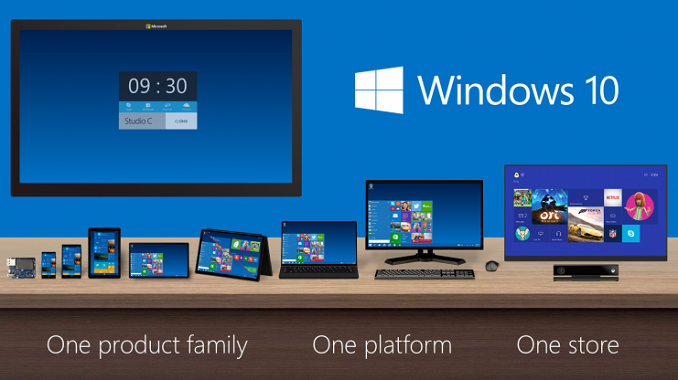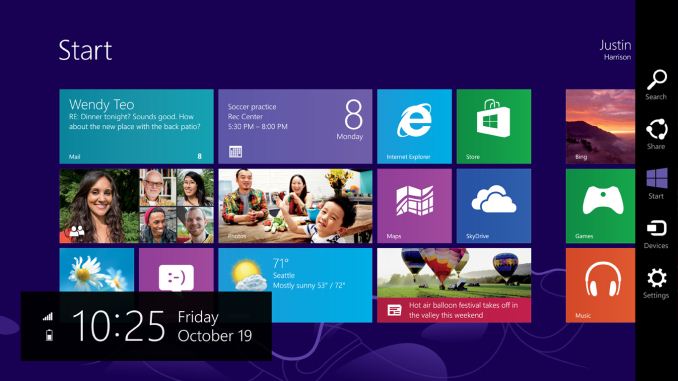Windows 10 Technical Preview First Impressions: The Return Of The Desktop
by Brett Howse on November 13, 2014 8:00 AM EST- Posted in
- Software
- Microsoft
- Windows 10

I’ve said this before, and I will reiterate it now. Windows 8, in general, is not perceived in a positive light. Not necessarily because of the lack of features, or even due to the touch first interface, but because from the start people did not buy into the paradigm. We can argue over why that was, and the specifics are likely different for every individual. But a big part of that was that Windows, which has had a familiar interface since Windows 95, had changed dramatically in look, feel, and general use. The traditional mouse and keyboard PC and notebook is a big part of the Windows user base, and especially at the beginning, Windows 8 did not cater to that crowd. While there were certainly improvements to the desktop, it was not enough to overcome the negative feelings of many users in regards to being productive on their PC. I say this as a fan of Windows 8.1, and I say this despite the positive review from this site. Windows 8 was an OS that worked, but had a steep learning curve that many people did not want to bother learning.
One of the biggest issues facing Windows 8 was just how much people liked Windows 7. Windows 7 was seen as the savior to Vista, and fixed many of its issues. But a lot of the initial problems with Vista were due to a major change in the driver model as well as the security model, which caused a lot of compatibility issues with older programs which expected administrator rights, as well as many hardware devices needed driver updates. With Windows 7, all of those changes were in the rear view mirror, allowing 7 to be a tweak of the overall UI and functionality rather than a rebuild of the OS from the ground up. With Windows 8, the move to touch first caused another dramatic upheaval. This time, rather than incompatible programs and hardware, we got a new Start Screen, a new runtime in WinRT, and a new app model with the Windows Store. For reasons that will never be made clear, the familiar start button was even removed, with the designers relying on hidden functions such as the hot corners to navigate around the OS with a mouse and keyboard. Luckily this change was reversed for Windows 8.1, with the start button returning, even if it still opened the Start Screen. With the Windows 8.1 Update, the system was made much more usable for a mouse and keyboard with the return of the menu bar to close apps, rather than dragging them down off the screen, and several other changes as well which brought the balance back somewhat to cover both touch interfaces as well as the mouse and keyboard.
 Windows 8 at launch in October 2012
Windows 8 at launch in October 2012
With Windows 8, Microsoft tried out an operating system which would work with a single interface across a breadth of hardware, from small form factor tablets, up to 30” monitor desktops. While they certainly succeeded in creating an interface that worked across all of those platforms, it was not ideally suited to any of them. With the tablet mode, the new Start Screen worked very well, and the charms menu and app switcher were fairly easy to use. But many of the settings and programs would be on the desktop, where touch only worked sparingly. Some desktop applications, such as Office, were created with a touch mode to increase the size of the onscreen elements, but overall the experience was subpar. Similarly, on the desktop, the touch interfaces were not ideal, and the hot corners certainly had issues especially on multi-monitor systems.
Windows 10 Technical Preview at launch
But now we come to Windows 10. Windows 10 is ditching the “One Interface to Rule them All” mentality, and moving to a more user friendly model of a single store across all platforms, and multiple interfaces to the same OS depending on the current usage model. We have not seen all of this in practice as of yet in the Technical Preview, but Microsoft has demonstrated their solution to this change in input mode with a feature they are calling Continuum.
The goal is that those that are on a keyboard and mouse based system will have the traditional start menu and desktop, with apps in windows, but if you are on a touch based device, or if you go on a 2-in-1 from keyboard to touch, the system will switch to the Windows 8 style start screen with full screen apps.
One of the keys to having this experience is an app model that allows a developer to target this different user interface paradigms. Microsoft’s solution to this is Universal Apps.











198 Comments
View All Comments
Imaginer - Thursday, November 13, 2014 - link
I personally WANT to KEEP the Start Screen on my desktop systems.The All Apps area does need improvement, in zeroing in on the selected folders when zooming out (by CTRL mouse wheel). The folders do need to be differentiated by color boxes.
I have absolutely no use of launching any application by desktop icons anymore, only using this area for scratch files I use.
And I have no need for a limited Start Menu pinning, where on the Start Screen I can pin an "infinite" amount of tiles, with a quick reveal with the Start key or the Start button.
Options. I know that it can be given. Much like there is backlash, I am giving my own if I do not keep my Start Screens on my pure desktop PCs. Otherwise, the rejoice of "return of desktop" is unwarranted, as FIle Explorer, Task Manager, Right Click power options, and Taskbar are all there to begin with.
Imaginer - Thursday, November 13, 2014 - link
I really am not that interested in drop shadows, but it is a graphical draining feature I can turn off, as in my Tablet PC of a Surface Pro 2, most if not all the time I am running windows maximized. And on the desktop, most to all of my monitors run as close to maximized.I don't mind that flat look, it is superficial at this point, to appease the "prettiness" type of people.
Brett Howse - Thursday, November 13, 2014 - link
You can use the Start Screen instead of the Start Menu it's just a checkbox in the Start Menu properties. Once Continuum appears, it will be even easier to switch since you can likely manually invoke that feature.zero2dash - Thursday, November 13, 2014 - link
I've played around with it in a VM, and it's certainly better than 8/8.1 but I don't think it's any better than 7 and I'm happy with (and used to) 7. Even if 10 is a free upgrade for 7 users, I don't think I'd take it.Seems like they've moved things around a bit in 10 (that may have also been moved in 8/8.1 and are simply in the same spot in 10), and I don't like this "relearning" that they think I have the time or energy to do. If I'm going to relearn an OS, it's gonna be Ubuntu or Fedora.
Zingam - Thursday, November 13, 2014 - link
On my left - a laptop with Windows 8.1 and on my right - a laptop with Windows 7. Conclusion: Windows 8.1 is so much nicer than Windows 7 (Windows 8 was lacking but Windows 8.1 is superior). Nuff said!Gunbuster - Thursday, November 13, 2014 - link
Is DirectAccess in the preview or do they have it locked down to "Windows 10 Enterprise" or whatever they are going to call it?I'm convinced Cisco is making payments to keep DirectAccess out of the mainstream so their VPN device customers don't instantly evaporate.
wiyosaya - Thursday, November 13, 2014 - link
In my opinion, overall cost is what drives business to move to a new OS, not features. Many businesses had only recently upgraded from NT to 7 when 8 came out. M$ seems to expect that everyone, including the business world, will just lock-step into line and upgrade at M$' slightest whim.As I see it, even without the learning curve of the new UI in 8, upgrading, after just completing an upgrade to 7, would have been prohibitively expensive for many businesses. Many articles I have seen point to the learning curve of the 8 UI as the singular reason that the business world failed to adopt it. What evidence is there for this? I am willing to bet that the main reason was cost, not learning curve - which is not all that steep except, perhaps, for the less technically inclined.
Hairs_ - Thursday, November 13, 2014 - link
The biggest hurdle for businesses is app compatibility, even more so than hardware or training costs.Businesses are still running mission critical functions on 70's mainframe systems, because replacing them is simply too expensive / frightening / difficult.
prime2515103 - Thursday, November 13, 2014 - link
Can the live tiles in the start menu be disabled and/or replaced with the selections that are in the Win7 start menu?Brett Howse - Thursday, November 13, 2014 - link
You can unpin whatever you would like from the Start Menu, and you can pin anything you'd like including desktop apps.